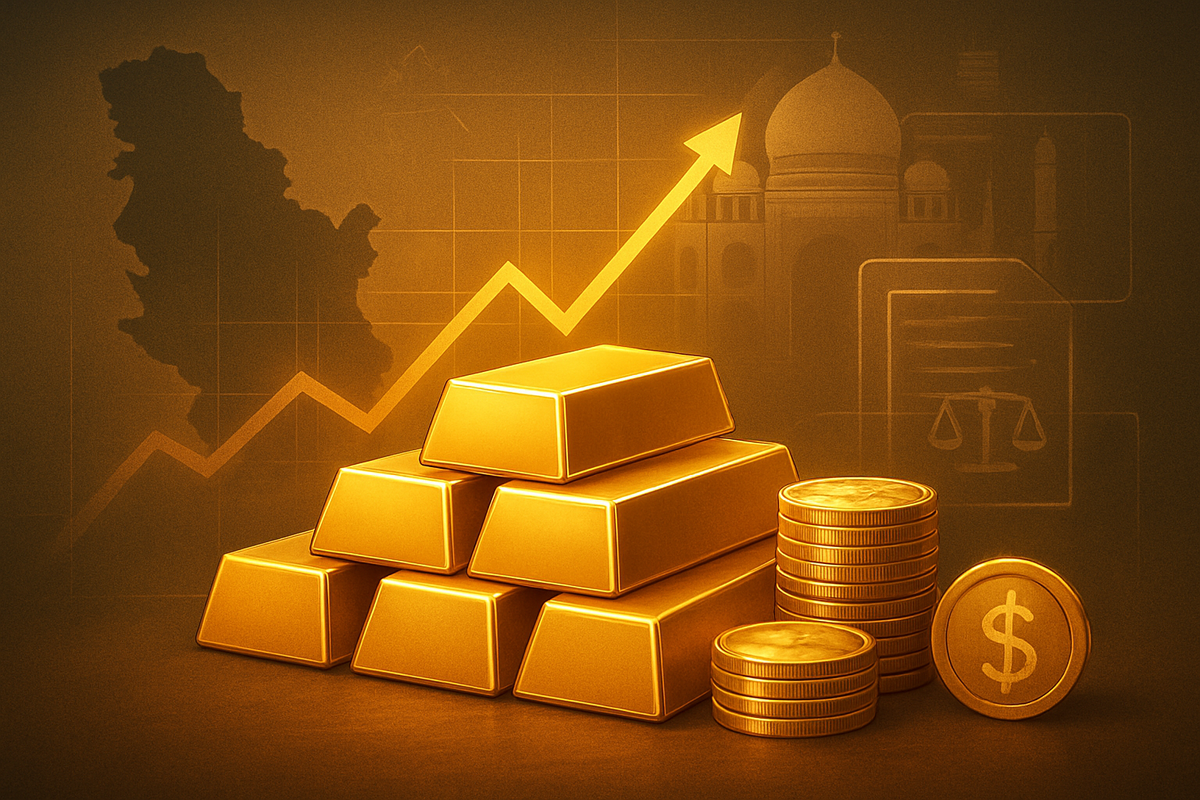
As global economic uncertainties persist and inflation concerns linger, gold has once again asserted its traditional role as a safe-haven asset, with prices soaring to unprecedented levels in late 2025. This resurgence is not merely a reflection of market volatility but is actively being shaped by significant structural developments, including the emergence of innovative gold investment products in new markets, such as Serbia's first dedicated gold fund, and a growing call for comprehensive national gold policies, exemplified by recent discussions in India. These trends are not only redefining how individuals and institutions access gold but are also prompting a reevaluation of the metal's strategic importance in national economies, promising a dynamic future for the global gold market.
The confluence of robust central bank buying, heightened investor appetite for safe havens, and strategic policy shifts is propelling gold into a new era. With prices hovering near record highs, financial institutions and governments alike are adapting to this elevated environment, introducing products and policies designed to integrate gold more formally into investment portfolios and national reserves, promising a dynamic future for the global gold market. These developments signal a maturing gold market, one where accessibility and strategic management are becoming as critical as the metal's intrinsic value.
Navigating the New Gold Rush: From Balkan Funds to Indian Policy Overhauls
The current gold market is characterized by a potent mix of surging prices and strategic innovations. As of November 5, 2025, gold traded around an impressive $3,963.58 per troy ounce, having seen a substantial 48.78% increase over the past year and reaching an all-time high of $4,381.58 in October 2025. This bullish trend is underpinned by several factors, including aggressive central bank accumulation, particularly from emerging markets like China, India, and Turkey, which collectively purchased 220 tonnes in Q3 2025. Geopolitical tensions, economic uncertainties, and persistent inflation concerns have further solidified gold's appeal as a crucial hedge. Gold-backed Exchange-Traded Funds (ETFs) have also witnessed a remarkable 134% surge in inflows in Q3 2025, totaling 222 metric tons, indicating a strong institutional and retail preference for liquid gold exposure.
A significant development in the European market is the launch of Serbia's first dedicated gold investment fund. On November 5, 2025, Banca Intesa's investment fund management unit, Intesa Invest, introduced the Gold & Silver Alternative fund. This pioneering fund is designed to offer Serbian investors a structured avenue to invest in precious metals, primarily gold and silver, and to a lesser extent, platinum and palladium, by investing in other specialized precious metal funds. The fund targets individuals seeking capital preservation and long-term returns, albeit with an acceptance of higher risk. A key incentive for investors is the eligibility for a tax credit under Serbian personal income tax law, allowing for a reduction in annual income tax by up to 50% of the invested amount. This initiative by Intesa Invest is a strategic move to broaden alternative investment options within Serbia and provide a hedge against inflation for its citizens. Simultaneously, the National Bank of Serbia (NBS) has been a consistent buyer of gold, increasing its reserves to 50.5 tonnes as of July 2025, and is actively repatriating all its gold reserves to enhance security during crises, further underscoring the nation's commitment to gold as a strategic asset.
Concurrently, India, one of the world's largest gold consumers, is grappling with the need for a more comprehensive national gold policy amid these soaring prices. While the Union Budget 2025 maintained the gold import duty at a decade-low of 6% to curb smuggling and encourage legal imports, the Directorate General of Foreign Trade (DGFT) has also tightened import regulations. Gold with 99.5% or higher purity in unwrought and semi-manufactured forms is now restricted, importable only through nominated agencies, qualified jewelers via the India International Bullion Exchange (IIBX), or India-UAE Tariff Rate Quota holders. New Harmonized System (HS) codes have also been introduced for various gold and precious metal forms to prevent duty evasion. Most notably, a report by the State Bank of India (SBI) in November 2025 called for a long-term national gold policy, emphasizing the need to clarify gold's role as a commodity or money in India. The report suggests moving beyond short-term demand-reducing measures and recycling existing stocks, advocating for a more strategic integration of gold into the Indian economy.
Market Movers: Who Gains and Who Adapts in the Gold Surge?
The current landscape of surging gold prices and evolving investment trends creates clear winners and prompts strategic adaptations for various market participants. Financial institutions and asset managers that offer gold-backed investment products are positioned to gain significantly. Companies like BlackRock (NYSE: BLK) and State Street Global Advisors (NYSE: STT), through their popular gold ETFs such as iShares Gold Trust (NYSE: IAU) and SPDR Gold Shares (NYSE: GLD), respectively, are seeing increased inflows, boosting their assets under management and fee revenues. The launch of the Gold & Silver Alternative fund by Intesa Invest in Serbia exemplifies how regional banks and investment firms can capitalize on this demand by introducing tailored products to their local markets.
Gold mining companies are direct beneficiaries of elevated gold prices. Major players such as Newmont Corporation (NYSE: NEM), Barrick Gold Corporation (NYSE: GOLD), and Agnico Eagle Mines Limited (NYSE: AEM) are experiencing higher revenues and potentially increased profitability as the value of their mined output rises. Sustained high prices can also incentivize these companies to invest in exploration and expand production, further solidifying their market positions. Additionally, companies involved in refining, vaulting, and trading physical gold, like Metalor Technologies or Johnson Matthey (LSE: JMAT), will see increased activity and demand for their services.
Conversely, while not necessarily "losers," some sectors may face challenges or require significant adaptation. Traditional investment products that offer lower returns or greater volatility in comparison to gold's current performance might see capital outflows as investors seek safer havens. Governments, particularly in countries with high gold consumption like India, face the ongoing challenge of managing both legal and illicit gold flows. While reduced import duties aim to curb smuggling, the persistent demand for physical gold can still fuel parallel markets if not effectively managed by comprehensive policies. The Indian jewelry industry, while culturally significant, could experience nuanced impacts; higher gold prices might deter some consumers due to affordability concerns, yet also increase the value of existing gold holdings, potentially boosting recycling.
A New Era for Gold: Broader Implications and Historical Parallels
The emerging trends in gold investment, marked by new financial products and calls for comprehensive national policies, signify a broader recalibration of gold's role in the global financial system. This movement is deeply intertwined with prevailing macroeconomic conditions, particularly persistent global inflation, heightened geopolitical instability, and a general search for portfolio diversification away from traditional fiat currencies and overvalued equities. Gold's performance as a safe-haven asset reinforces its historical utility, but the structured approaches now being adopted by nations and financial institutions elevate its status beyond a mere commodity.
These developments could trigger ripple effects across various markets. Increased institutional and retail investment in gold, facilitated by products like Serbia's new fund, could divert capital from other asset classes, including bonds and potentially even some equity sectors, especially those perceived as more volatile. The strategic accumulation of gold by central banks, a trend that has accelerated throughout 2025, signals a broader move towards de-dollarization and reserve diversification, which could have long-term implications for the U.S. dollar's global dominance. Furthermore, if other countries follow India's lead in developing comprehensive national gold policies, it could lead to a more formalized and transparent global gold market, potentially reducing illicit trade and enhancing financial stability.
From a regulatory standpoint, the introduction of new gold investment products will necessitate robust oversight to protect investors and ensure market integrity. Governments may face pressure to harmonize gold-related regulations internationally to prevent regulatory arbitrage. Historically, periods of high inflation and geopolitical uncertainty have consistently driven gold demand. The current environment echoes the 1970s, a decade marked by stagflation and geopolitical turmoil, during which gold prices surged dramatically. The key difference now is the sophisticated financial infrastructure, including ETFs and structured funds, that allows for broader and more liquid access to gold, potentially amplifying its market movements compared to previous eras. The proactive policy discussions in India also distinguish this period, moving beyond reactive measures to consider gold's long-term strategic integration.
The Road Ahead: Gold's Enduring Appeal and Evolving Landscape
Looking ahead, the trajectory of gold investment is poised for continued dynamism, shaped by both short-term market fluctuations and long-term strategic shifts. In the short term, the prevailing global uncertainties, coupled with robust central bank demand and sustained investor interest, are likely to keep gold prices elevated. While potential shifts in interest rate expectations from major central banks could introduce some volatility, the underlying bullish sentiment for gold as a hedge against inflation and geopolitical risk is expected to persist. We could see further inflows into gold-backed ETFs and an expansion of physical gold purchases, particularly from Asian markets.
In the long term, the strategic pivots by financial institutions and governments will be critical. The success of new investment products, such as Serbia's Gold & Silver Alternative fund, could inspire similar offerings in other emerging markets, democratizing access to gold investment globally. For nations like India, the development and implementation of a comprehensive national gold policy could fundamentally alter its domestic gold market, potentially leading to new financial instruments, better integration of gold into the formal economy, and a reduction in the grey market. This could also influence gold loan markets and the overall financialization of gold assets.
Market opportunities will emerge for financial technology companies specializing in precious metal platforms, secure digital gold offerings, and blockchain-based gold trading. Challenges will include navigating evolving regulatory frameworks, managing price volatility, and ensuring adequate supply chain integrity for physical gold. Potential scenarios include a sustained "golden bull run" if global uncertainties intensify, leading to gold becoming an even more prominent component of diversified portfolios. Alternatively, a stabilization of geopolitical tensions and a return to more conventional economic growth could see gold prices consolidate, though its role as a strategic reserve asset is unlikely to diminish.
Concluding Thoughts: Gold's Resurgent Role in a Shifting Global Economy
The current surge in gold prices, coupled with the introduction of innovative investment products and calls for comprehensive national policies, underscores a profound reassessment of gold's role in the global financial landscape. Key takeaways include gold's undeniable appeal as a safe-haven asset amidst inflation and geopolitical instability, the increasing sophistication of gold investment avenues, and the strategic importance governments are placing on managing and integrating gold into their national economies. The launch of Serbia's first gold fund and India's pursuit of a long-term gold policy are not isolated events but rather indicative of a broader trend where nations and investors are actively seeking robust, tangible assets to safeguard wealth.
Moving forward, the gold market is likely to remain a focal point for investors and policymakers alike. Its performance will continue to be influenced by macroeconomic indicators, central bank actions, and geopolitical developments. Investors should closely monitor global inflation data, interest rate decisions from major central banks, and any further policy announcements regarding gold from significant consumer and producer nations. The evolution of gold-backed financial products, particularly in emerging markets, will also be a crucial area to watch, as these innovations expand accessibility and potentially reshape investment flows. Ultimately, gold is reasserting its enduring significance, not just as a store of value, but as a dynamic and increasingly integrated component of the modern financial system.
This content is intended for informational purposes only and is not financial advice





